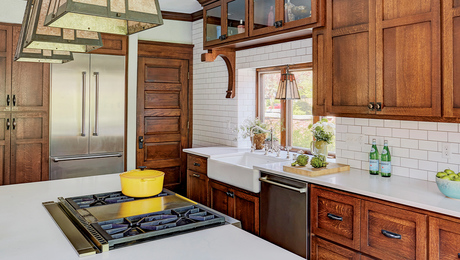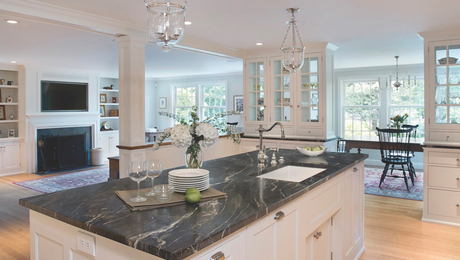A Magical Design Process
One way to ensure an emotional connection with your clients is to provide them with a design process that excites them.

“Every great magic trick consists of three parts,” according to Christopher Priest, author of The Prestige. Priest calls these parts, or acts, The Pledge, The Turn, and The Prestige.
The parts of the trick work like this: The magician shows you something ordinary, makes it do something extraordinary, and then brings it back to reality.
Builders have a similar process. They call this process design, not magic. The magician amazes his audience with sleight of hand and illusion. The builder has to produce a similar experience for his clients without trickery or deception. He must know how to deliver a design with the same precision as the well-rehearsed magician.
A THREE-ACT SHOW
Even the best construction documents do not show all the details for the final product. Most builders must perform some kind of design services to move their clients from initial plans to final completion. Like the parts of a magic trick, you (the builder), should walk your clients through a three-step design process. This will ensure the quality, scope, and price of the project.
THE PLEDGE — A CONCEPTUAL DESIGN
The magic trick starts with The Pledge. The magician reveals the object. You start the design process with the Conceptual Design.
The owner reveals to you the object of desire through photographs, sketches, or a description. The object is not real at this point. It is a concept, and you should treat it as such.
The purpose of the Conceptual Design phase is to gather information about the specifications, intended use, quality, and function of the project.
You should discuss a high budget range with your client (see my post about Price Anchoring). You should not quote the project during this phase. Provide enough options to the owner to convey the concept of the design.
Submit the Conceptual Design to the owner for comment and approval. The Conceptual Design package may be hand sketches and rough drafts of specifications.
For example:
The Conceptual Design may include three options – A, B, and C. Prepare a budget range that covers all options. The owner may decide that she likes the layout of option A, with the style of option C. She does not like option B.
When your client eliminates some options, move the client to the next phase of the Design Process – The Preliminary Design.
THE TURN — THE PRELIMINARY DESIGN
The second act of the magic trick is The Turn. The magician takes the ordinary object and makes it extraordinary. I call the second part of the design process the Preliminary Design.
Take the information gathered during the Conceptual Design and transform the object into a Preliminary Design. The Preliminary Design is more specific than the Conceptual Design in both scope and function. You should attempt to produce one option at this phase of the design.
The design should be complete. But the preliminary option may have allowances for undetermined elements.
For example:
The customer wants an entertainment center and mantle in the great room. You have eliminated some layout options and determined the best option for the space. But the owners are not sure if they want stain-grade millwork or paint-grade. You provide them with a single layout and a budget range for each of the finishing options.
This process also applies to custom building projects as well. You determined the general floor plan and elevations, but have not determined the finish schedule. You provide a budget range and general allowances for the design.
The main purpose of the the Preliminary Design phase is to make the specific decisions about the project. You also must determine the budget for the scope of work. Revise the Preliminary Design until you and the client have made all the decisions necessary to quote the work.
WORKING WITH A PROFESSIONAL DESIGNER
Most projects involving an architect or designer start in the Preliminary Design phase. Although these professionals may have provided a layout and design, you will have to work out the details of construction. You may produce shop drawings or other plans to convey these details. You should consider this due diligence as part of the Preliminary Design phase. The architect or designer has completed her ‘final’ design. But her “final” design may be your Preliminary Design.*
*This is not intended to say that the professional designer did not complete her job. I am identifying where the scope of one professional may end and the scope of another professional may begin.
You have made all the necessary revisions and priced the scope of work. Now you are ready to submit the design to the client for approval of the Preliminary Design. Upon approval of the Preliminary Design, move the project into the third step of the design process – The Final Design.
THE PRESTIGE — THE FINAL DESIGN
The third act of the magic trick is The Prestige. The magician has amazed the audience by making the ordinary into the extraordinary. Yet, the audience sits in stunned silence. They do not applaud. The audience erupts with applause after the magician brings the object back to reality. The Final Design is the third part of this process.
The purpose of the Final Design is to bring all the elements of the project together. The layout, style, and function are on display. The scope, quality, and schedule are crystal clear. There is no more design work. The magic is complete. It is time for execution.
Issue a contract and collect a deposit.
Unlike the magician’s performance, your design process is more than an illusion or sleight of hand. This is your craft. Your design process should reflect your craftsmanship as well.
Your design process is a system of communication and analysis. This system guarantees you will deliver exactly what your customer wants. This three-step design process allows you and your clients to discuss, revise, verify and agree to the entire project.
The Conceptual Design gets the ideas down on paper and shows the available options for a general budget range.
The Preliminary Design narrows the scope of the project and sets a budget based on that scope.
The Final Design completes the process and provides all the information to build the project. This phase includes the final layout, style, function, price, quality, and schedule.
Everyone likes a good magic trick. The sense of wonder and amazement that the magician creates can be memorizing. Your customers should feel the same way about your work.
You will create excitement and clarity about the design process with this system. You can execute the project with efficiency and precision.
Magicians never reveal their secrets, but successful builders do.
The secret is that there is no secret. There is just a process.
And the process can be magical for your clients.
Follow me on Instagram @shawnvandyke, LinkedIn, Facebook, or shawnvandyke.com to learn more about how to streamline your construction business.
Fine Homebuilding Recommended Products
Fine Homebuilding receives a commission for items purchased through links on this site, including Amazon Associates and other affiliate advertising programs.

Graphic Guide to Frame Construction

Homebody: A Guide to Creating Spaces You Never Want to Leave

Code Check 10th Edition: An Illustrated Guide to Building a Safe House





























View Comments
Excellent. Thank you.
fantastic work nice
magical is magic design